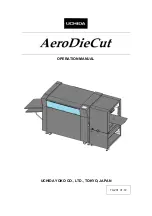
6.3
Undercut
Do not cut into the base course (frequently chip‐
ped stones and gravel) when cutting roadway
pavement – cutting in chipped stones and gravel
is revealed by light-colored dust – excessive
undercut may occur as a result – Danger of shat‐
tering!
6.4
Built-up edges, sharpen
Built-up edges take the form of a light gray
deposit on the tops of the diamond segments.
This deposit on the segments clogs the dia‐
monds and blunts the segments.
Built-up edges can form:
–
when cutting extremely hard materials, e. g.,
granite
–
with incorrect handling, e. g., excessive feed
effort
Built-up edges increase vibration, reduce cutting
performance, and cause formation of sparks.
At the first signs of built-up edges, immediately
"sharpen" the diamond abrasive wheel – to do
this, briefly cut through abrasive material such as
sandstone, aerated concrete or asphalt.
Addition of water prevents the formation of built-
up edges.
If work continues with dull segments, these may
soften due to the high heat generated – the
parent wheel is annealed and its strength is com‐
promised – this can lead to stresses that are
clearly recognizable by gyrations of the abrasive
wheel. Do not continue to use the abrasive wheel
– Risk of accident!
6.5
Troubleshooting
6.5.1
Abrasive wheel
Defects
Cause
Remedy
ragged edges or cut surfaces,
crooked cut
Deviation in radial or axial run-out Contact a servicing dealer
1)
heavy wear on the sides of the
segments
Abrasive wheel gyrates
use a new abrasive wheel
ragged edges, crooked cut, no
cutting performance, generation
of sparks
Abrasive wheel is dull; built-up
edges with abrasive wheels for
stone
Sharpen abrasive wheels for
stone by briefly cutting through
abrasive materials; replace
1)
STIHL recommends STIHL servicing dealers
6 Diamond Abrasive Wheels
English
0458-753-8321-C
15
















































